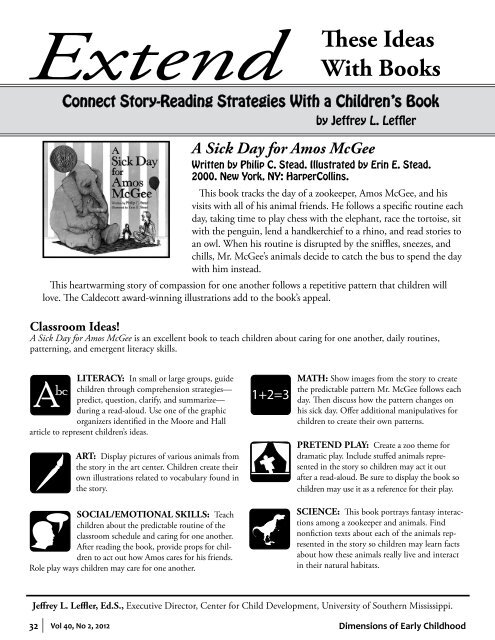Water Play - Southern Early Childhood Association
Water Play - Southern Early Childhood Association
Water Play - Southern Early Childhood Association
Create successful ePaper yourself
Turn your PDF publications into a flip-book with our unique Google optimized e-Paper software.
These Ideas<br />
With Books<br />
Connect Story-Reading Strategies With a Children’s Book<br />
by Jeffrey L. Leffler<br />
A Sick Day for Amos McGee<br />
Written by Philip C. Stead. Illustrated by Erin E. Stead.<br />
2000. New York, NY: HarperCollins.<br />
This book tracks the day of a zookeeper, Amos McGee, and his<br />
visits with all of his animal friends. He follows a specific routine each<br />
day, taking time to play chess with the elephant, race the tortoise, sit<br />
with the penguin, lend a handkerchief to a rhino, and read stories to<br />
an owl. When his routine is disrupted by the sniffles, sneezes, and<br />
chills, Mr. McGee’s animals decide to catch the bus to spend the day<br />
with him instead.<br />
This heartwarming story of compassion for one another follows a repetitive pattern that children will<br />
love. The Caldecott award-winning illustrations add to the book’s appeal.<br />
Classroom Ideas!<br />
A Sick Day for Amos McGee is an excellent book to teach children about caring for one another, daily routines,<br />
patterning, and emergent literacy skills.<br />
LITERACY: In small or large groups, guide<br />
A bc children through comprehension strategies—<br />
predict, question, clarify, and summarize—<br />
during a read-aloud. Use one of the graphic<br />
organizers identified in the Moore and Hall<br />
article to represent children’s ideas.<br />
ART: Display pictures of various animals from<br />
the story in the art center. Children create their<br />
own illustrations related to vocabulary found in<br />
the story.<br />
SOCIAL/EMOTIONAL SKILLS: Teach<br />
children about the predictable routine of the<br />
classroom schedule and caring for one another.<br />
After reading the book, provide props for children<br />
to act out how Amos cares for his friends.<br />
Role play ways children may care for one another.<br />
1+2=3<br />
MATH: Show images from the story to create<br />
the predictable pattern Mr. McGee follows each<br />
day. Then discuss how the pattern changes on<br />
his sick day. Offer additional manipulatives for<br />
children to create their own patterns.<br />
PRETEND PLAY: Create a zoo theme for<br />
dramatic play. Include stuffed animals represented<br />
in the story so children may act it out<br />
after a read-aloud. Be sure to display the book so<br />
children may use it as a reference for their play.<br />
SCIENCE: This book portrays fantasy interactions<br />
among a zookeeper and animals. Find<br />
nonfiction texts about each of the animals represented<br />
in the story so children may learn facts<br />
about how these animals really live and interact<br />
in their natural habitats.<br />
Jeffrey L. Leffler, Ed.S., Executive Director, Center for Child Development, University of <strong>Southern</strong> Mississippi.<br />
32 Vol 40, No 2, 2012<br />
Dimensions of <strong>Early</strong> <strong>Childhood</strong>
















